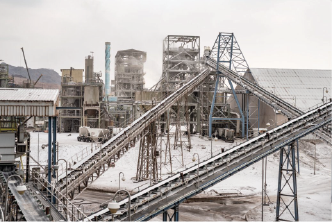Cold resistance
THE EFFECTS OF EXTREME COLD ON RUBBER
When the ambient temperature descends below 0°C rubber rapidly begins to lose its elasticity and flexibility as well as its ability to resist wear (abrasion), impact and cutting. The covers and the rubber between the plies in the carcass also begin to crack. As the temperature continues to fall the belt becomes so stiff and rigid it is unable to trough and pass around pulleys. Ultimately, the belt will break because frozen rubber becomes as brittle as glass.
DUNLOP SOLUTIONS
All Dunlop abrasion resistant cover grades can withstand temperatures as low as -30 to -40°C. However, because of their different rubber composition, it is inadvisable to operate belts with other cover qualities such as oil or fire resistant in temperatures lower than -20°C. In these situations, conveyors should only be fitted with belts that have been specially designed for the purpose. The Dunlop Coldstar range of abrasion resistant, oil resistant and fire resistant rubber cover grades have been specifically engineered to function without difficulty in some of the coldest operating temperatures known to man.
A QUICK REFERENCE GUIDE TO DUNLOP COLD RESISTANT COVERS
-60°C Coldstar RAS: cold and high abrasion resistant.
-30°C Coldstar ROS: resistant to mineral, animal and vegetable oils.
-30°C Coldstar ROM: resistant to vegetable and animal oils.
-40°C Coldstar BV K: fire resistant according to EN 12882 Class 2A.
-40°C Coldstar BV S: fire resistant according to EN 12882 Class 2B.
-30°C Coldstar VT: fire resistant according to EN 12882 up to Class 5A.
The temperatures shown indicate the limit until which the belt is still
flexible enough to function normally.
Read more about APPLICABLE QUALITY STANDARDS & TEST METHODS
Download technical bulletin
In this document, you can find information about cold resistance in conveyor belting.
Cold resistance belts

Superfort®
Fenner Dunlop Superfort ‘long life’ multi-ply conveyor belts have a long history of outstanding reliability and durability.

